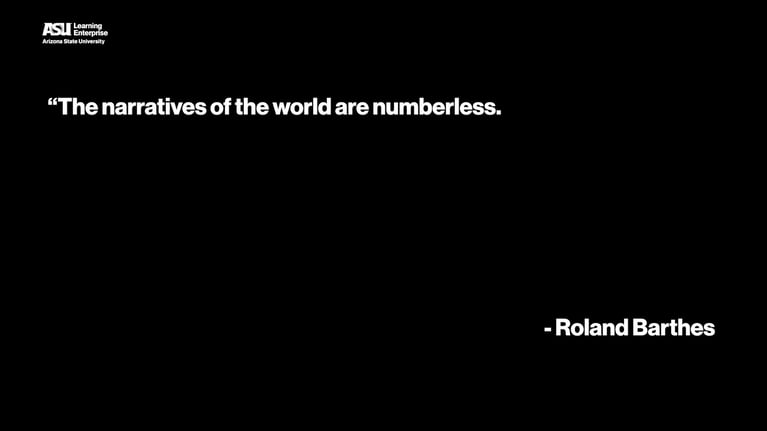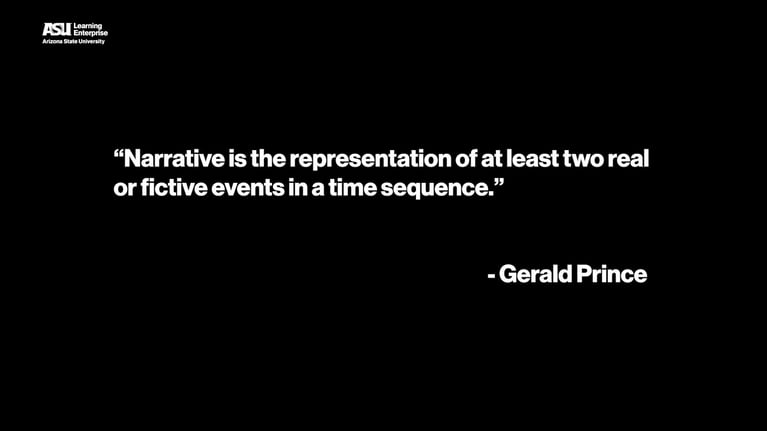Narrative is the representation of an event or series of events, composed of two parts: story and narrative discourse. The story consists of events (actions and happenings) and existents (characters and setting), while narrative discourse encompasses the medium through which the story is communicated and the structure of narrative transmission. Understanding the anatomy of narrative allows us to analyze and comprehend stories in various contexts, whether weaving battlefield legends or exploring scientific concepts. Awareness of narrative formulation is crucial as narratives surround us and possess significant impact.
Narratologist, H. Porter Abbott defines narrative as, “The representation of an event or series of events.”
Other people define narrative differently, but this is a handy definition for our purposes. Notice that is a very humble definition. It’s tiny, granular, almost atomic.
Like defining water as H20. Water can take many forms. It can be a bottle of water. A cool summer rain. A puddle, a river, an ice cube in your drink. It can be the fog on a gloomy morning, the tears you cry when you’re sad. It can be both the ocean that a boat sails in, and the iceberg that sinks it.
Narrative is like that, too. It can take on seemingly countless forms and structures. But, like all our examples of water are H20, all forms of narrative are representations of events.
If we want to understand water, we might look at its component parts. Two hydrogen atoms and one oxygen atom. If we are a mechanic, and want to understand an engine, we would want to know what all its parts are.
So to understand narrative, we want to identify its component parts. Its anatomy.
What is narrative made of?
Narratologist Seymour Chatman devised a useful anatomy of narrative.
Narrative has two parts: Story and Narrative Discourse
Story is a chronological series of events involving existents.
Narrative Discourse is the means by which the story is represented.
The story is the content. Narrative discourse is how that content is expressed or represented.
Like water and narrative, story is composed of two elements: Events
and Existents
Events are things that happen that create a change in the world of the story. Existents are objects that exist in the world of the story.
Story is composed of verbs and nouns. Events are the verbs and existents are the nouns.
There are two kinds of events: Actions and Happenings
Actions are events caused by characters—like Romeo kissing Juliet or Bugs Bunny kissing Elmer Fudd. Happenings are events that are not caused by an agent—like a rainstorm or an anvil falling on Wile E. Coyote.
There are two kinds of existents: Characters and Setting
Characters are existents that exhibit agency and perform actions. Characters are nouns that do things in the world of the story. Katniss, Cinderella, and T’Challa the Black Panther are all examples of characters.
Setting is all the other objects in the world. Items of setting don’t possess agency. They don’t do things in the world. Katniss’s bow, Cinderella’s slipper, T’Challa’s mask are examples.
So there we have Story. Now, let’s go back to look at Narrative Discourse.
Narrative discourse has, yep, you guessed it, two component parts:
Media and The structure of narrative transmission.
Media is the material substance through which the story is communicated. Examples include written or spoken language, film, dance, theatre, painting, comics, video games, etc.
The structure of narrative transmission is simply the narrative discourse minus the media. In a film, this can include the ordering of events, the actors, the lighting, the dialogue, the editing, etc. In a novel, this includes, among other things, the ordering of events and the specific language used by the author. In a comic book, this includes the words, the images, the colors, and the way the panels are arranged.
So there you have it. That is Seymour Chatman’s anatomy of narrative. It’s like the atomic structure of narrative. Water is H20. Narrative is, well, this.


